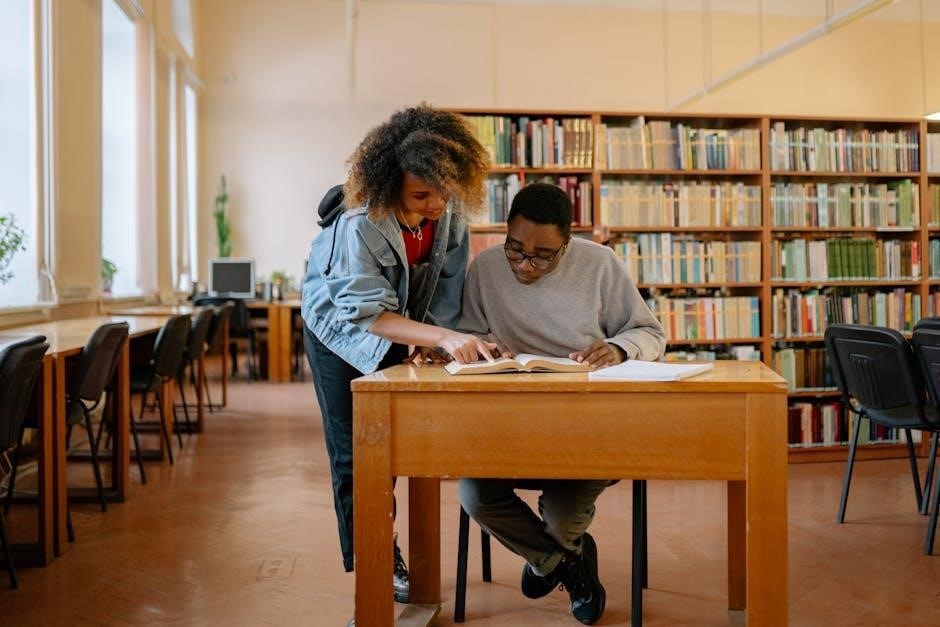compréhension de texte 6ème avec corrigé pdf
Text comprehension exercises for 6th grade French curriculum are essential for improving reading and analytical skills. These exercises include narratives, questionnaires, and corrected texts to enhance understanding and critical thinking.
1.1. Importance of Text Comprehension in 6th Grade French Curriculum
Text comprehension is a cornerstone of the 6th grade French curriculum, fostering critical thinking and linguistic skills. It enables students to analyze narratives, understand vocabulary, and grasp complex ideas. Regular exercises with corrected versions help students identify errors and improve accuracy. These activities also enhance reading fluency and prepare pupils for standardized tests. By mastering comprehension, students build a strong foundation for future academic success and develop essential skills for real-life applications.
1.2. Overview of Common Exercise Types
Common exercise types for 6th grade text comprehension include reading passages followed by multiple-choice questions, true/false statements, and short-answer responses. Some exercises involve ordering sentences to reconstruct a story, while others focus on filling in missing words or associating words with characters. These activities are often accompanied by detailed correction guides to provide immediate feedback. Additionally, oral reading exercises and group discussions are used to reinforce understanding and promote collaborative learning. These varied exercises cater to different learning styles, ensuring comprehensive skill development.

Key Components of a Comprehension Exercise
A comprehension exercise typically includes a selected narrative, followed by structured questions to assess understanding. Correction guides provide feedback, ensuring students can evaluate and improve their responses effectively.
2.1. Text Selection: Choosing Appropriate Narratives
Selecting suitable texts is crucial for effective comprehension exercises. Narratives should align with the 6th-grade curriculum, offering engaging and age-appropriate content. They must be clear, concise, and relevant to students’ interests, ensuring comprehension is both challenging and achievable. Texts like L’Odyssée or Le Petit Prince are often chosen for their literary value and ability to stimulate critical thinking. These stories provide a solid foundation for developing reading skills and fostering a deeper understanding of French literature.
2.2. Questionnaires: Designing Effective Questions

Effective questionnaires are vital for assessing comprehension. Questions should be clear, specific, and aligned with learning objectives. They should encourage students to engage deeply with the text, promoting critical thinking and analysis. Open-ended questions allow students to express their understanding fully, while multiple-choice options can reinforce key concepts; Additionally, questions should guide students to identify main ideas, make inferences, and connect themes to their own experiences, fostering a comprehensive grasp of the narrative.
2.3. Correction Guides: Enhancing Learning Through Feedback
Correction guides provide detailed feedback, helping students understand their strengths and areas for improvement. They include explanations for correct and incorrect answers, enabling learners to grasp concepts more effectively. These guides often feature annotated texts, highlighting key vocabulary and sentence structures. By reviewing corrections, students can identify patterns in their mistakes and refine their comprehension skills. Feedback is tailored to promote self-assessment and independent learning, ensuring continuous progress in text comprehension.

Strategies for Improving Text Comprehension
Strategies include pre-reading activities, active reading techniques, and post-reading tasks to enhance understanding. These methods help students engage deeply with texts, fostering better retention and analytical skills over time.
3.1. Pre-Reading Activities: Setting the Context
Pre-reading activities are crucial for engaging students and building foundational understanding. These include discussing themes, introducing vocabulary, and providing background information about the text. For example, before reading L’Odyssée, teachers might explore mythological themes or discuss the author’s style. Similarly, for Le Petit Prince, activities could involve reflecting on friendship and loneliness. These exercises help students connect with the material, fostering curiosity and improving comprehension. By setting the context, educators create a supportive environment for students to interpret and analyze texts effectively.
3.2. Reading Techniques: Active Reading and Highlighting
Active reading involves engaging deeply with the text to understand its meaning. Techniques like highlighting key phrases, underlining important details, and note-taking in the margins are effective. Students are encouraged to ask questions, predict outcomes, and make connections to prior knowledge. Highlighting helps identify main ideas and supporting evidence, while note-taking aids in retaining information. These methods promote focused reading, enabling students to analyze and interpret texts more effectively. Regular practice of these techniques enhances comprehension and prepares students for independent learning.
3.3. Post-Reading Tasks: Summarization and Discussion
Post-reading tasks, such as summarization and discussion, reinforce understanding and critical thinking. Students summarize texts to identify key ideas and details, ensuring comprehension. Group discussions encourage sharing perspectives, analyzing characters, and interpreting themes. These activities promote deeper engagement with the text, fostering communication and collaboration. Summarization helps students synthesize information, while discussions enhance their ability to articulate thoughts and defend interpretations. Both tasks are essential for developing analytical and expressive skills, preparing students for advanced literary analysis.

Popular Texts for 6th Grade Comprehension Exercises
Popular texts for 6th-grade comprehension exercises include “L’Odyssée,” “Le Petit Prince,” and contemporary short stories. These narratives with exercises and corrigés enhance French comprehension effectively.
4.1. “L’Odyssée” by Homer: Extracts and Questions
Extracts from “L’Odyssée” by Homer are widely used for 6th-grade comprehension exercises. These narratives, often accompanied by questionnaires, focus on themes like adventure and perseverance. Students analyze key events, such as Odysseus’s journey, to develop critical thinking. Exercises include ordering sentences, completing missing words, and associating terms with characters or events. Detailed corrigés provide feedback, helping students assess their understanding. These activities enhance French comprehension while introducing classical literature, making learning engaging and effective for young learners.
4.2. “Le Petit Prince” by Antoine de Saint-Exupéry: Comprehension Activities
Comprehension activities based on “Le Petit Prince” focus on themes like friendship, responsibility, and the importance of human connections. Exercises include reading extracts, answering guided questions, and completing tasks such as ordering sentences or associating words with characters. For example, students might analyze the relationship between the prince and the fox or reflect on the meaning of “apprioiser.” Correction guides and self-assessment tools help students evaluate their understanding, while group discussions enhance collaborative learning and deeper text interpretation.
4.3. Contemporary Short Stories for Engaging Students
Contemporary short stories are ideal for engaging 6th-grade students, offering relatable themes and diverse characters. These narratives often explore modern issues, making them relevant to young learners. Exercises include reading comprehension questions, sentence ordering, and vocabulary matching. Stories like “Derniers pas sur la banquise” or “L’Éducation de Mowgli” provide rich contexts for analysis. Correction guides and self-assessment tools help students track their progress, while group discussions foster deeper understanding and collaborative learning, ensuring a dynamic and interactive approach to text comprehension.

Exercise Types for Autonomous Practice
Autonomous practice involves interactive tasks like ordering sentences, completing missing words, and associating words with characters or events. These exercises enhance independent learning and comprehension skills effectively.
5;1. Ordering Sentences to Reconstruct a Story
Reconstructing a story by ordering sentences is a popular exercise. Students arrange scrambled sentences chronologically to form a coherent narrative. This activity improves understanding of plot structure and sequence, enhancing comprehension skills. It also develops critical thinking and attention to detail. With a provided corrigé, students can self-correct, fostering independent learning. This method is effective for engaging students and reinforcing their ability to follow a storyline, making it a valuable tool in language education.
5.2. Completing Missing Words in a Text
Completing missing words in a text is an engaging exercise that enhances vocabulary and comprehension. Students fill in blanks with appropriate words, ensuring the text remains coherent. This activity strengthens linguistic skills and contextual understanding. Correction guides provide feedback, helping students learn from errors. It is particularly effective for reinforcing new vocabulary and improving reading fluency. By practicing this exercise, students develop the ability to infer meanings from context, a crucial skill for advanced comprehension. Regular practice with diverse texts ensures steady progress in language mastery.
5.3. Associating Words with Characters or Events
Associating words with characters or events enhances comprehension by linking vocabulary to narrative elements. Students match words to specific characters or events, fostering deeper understanding of the text. This exercise improves vocabulary retention and analytical skills. Correction guides provide feedback, ensuring accuracy. It encourages students to identify key themes and relationships within stories. Regular practice with diverse texts strengthens their ability to connect language with context, preparing them for more complex literary analyses in higher grades. This method is particularly effective for engaging students with narrative structures and character development.

Correction and Self-Assessment Tools
Correction and self-assessment tools, like corrigés and feedback templates, help students and educators evaluate comprehension in detail. These resources guide independent learning and track progress effectively.
6.1. Detailed Corrigés for Exercises
Detailed corrigés provide step-by-step corrections and explanations for comprehension exercises. They help students identify errors, understand complex questions, and improve their analytical skills. These corrected versions often include annotations, clarifying why certain answers are correct or incorrect. By aligning with learning objectives, corrigés enable students to review their work independently and gain insights into common pitfalls. This tool is invaluable for both self-assessment and teacher feedback, fostering a deeper understanding of the material and enhancing overall performance in text comprehension tasks. They are tailored to meet the needs of 6th-grade students, ensuring clarity and effectiveness in learning.
6.2. Self-Evaluation Guides for Students
Self-evaluation guides empower students to assess their own comprehension skills. These tools typically include checklists, reflection questions, and scoring systems. Students can identify strengths, areas for improvement, and track progress. Guides often align with exercise objectives, encouraging independent learning. By using these resources, students develop critical thinking and self-assessment abilities, fostering confidence and accountability. Regular self-evaluation helps students refine their understanding and approach to texts, preparing them for more complex challenges in reading and analysis.
6.3. Teacher Feedback Templates
Teacher feedback templates provide structured ways to evaluate student performance. These templates often include specific criteria, such as understanding of the text, accuracy in responses, and use of evidence. They allow educators to offer constructive comments, highlighting strengths and areas needing improvement. Feedback templates can be customized to align with lesson goals and support individualized instruction. By using these tools, teachers can deliver consistent, clear, and actionable feedback, helping students grow in their comprehension and analytical skills effectively.

Oral and Autonomous Activities
Oral reading exercises and autonomous tasks promote active learning. Students engage in reading texts aloud, while group activities foster collaborative comprehension and independent practice, enhancing overall language skills.

7;1. Oral Reading Exercises
Oral reading exercises are vital for improving fluency and comprehension. Students read texts aloud, focusing on pronunciation and intonation. Teachers provide feedback, correcting errors and enhancing expression. These activities also include group readings, where peers listen and discuss, fostering collaborative learning. Regular oral practice builds confidence and strengthens language skills, preparing students for more complex texts and assessments. Such exercises are often followed by discussions to ensure understanding and reinforce retention of the material covered. This method is both engaging and effective for young learners.
7.2. Autonomous Work in Class
Autonomous work in class encourages students to take charge of their learning. They engage in self-directed activities, such as reading comprehension exercises, using PDF resources and correction guides. This approach fosters independence and self-management skills. Students can choose exercises that match their level and interests, working at their own pace. Digital tools and printed materials provide access to texts, questionnaires, and answers, enabling immediate feedback. Autonomous work enhances accountability and prepares students for independent learning, promoting both academic growth and personal development; It’s a cornerstone of effective classroom practice.
7.3. Group Activities for Collaborative Learning
Group activities foster collaborative learning, encouraging students to work together on comprehension exercises. They share insights, discuss interpretations, and solve problems collectively. These tasks, such as analyzing texts or completing exercises, promote teamwork and communication. Group work also allows peers to learn from one another, reinforcing understanding and critical thinking. Correction guides provide feedback, helping students refine their skills. Collaborative learning builds confidence and social skills, preparing students for real-world interactions while enhancing their grasp of textual content. It’s a dynamic approach to education that combines socialization with academic growth.

Additional Resources and References
Supplement learning with PDF worksheets, online platforms, and teacher-created materials. These resources offer diverse exercises, correction guides, and engaging activities to support text comprehension skills development effectively.
8.1. Online Platforms for Supplementary Materials
Online platforms offer a wealth of resources for text comprehension exercises. Websites like Pinterest provide inspiration and downloadable materials, while educational sites offer PDFs with exercises, questionnaires, and correction guides. These platforms cater to diverse learning needs, featuring activities like ordering sentences, completing missing words, and associating words with characters. They are ideal for both classroom and home use, supporting teachers and students with engaging and structured materials to enhance comprehension skills effectively.
8.2. Recommended PDF Resources
Recommended PDF resources for 6th-grade text comprehension include a variety of exercises, correction guides, and engaging activities. These materials often feature narratives, questionnaires, and tasks like ordering sentences or completing missing words. Many PDFs are designed for autonomous practice, offering detailed corrigés and self-assessment tools. Popular texts like “L’Odyssée” and “Le Petit Prince” are frequently included with comprehension questions. These resources are ideal for both teachers and students, providing structured and interactive learning opportunities to enhance reading and analytical skills effectively.
8.3. Teacher-Designed Worksheets
Teacher-designed worksheets are tailored to meet specific learning objectives, offering a variety of comprehension exercises. These often include fill-in-the-blank tasks, word matching, and questionnaires. Worksheets may focus on identifying main ideas, making inferences, or analyzing characters. Many include correction guides, enabling students to self-assess and understand their mistakes. Designed to align with curriculum goals, these resources are adaptable to different skill levels and provide structured practice for improving text comprehension, fostering independent learning and critical thinking skills effectively.
Text comprehension exercises are vital for developing reading skills in 6th graders. Using corrected texts and interactive activities, students enhance understanding and critical thinking, fostering a deeper appreciation for French literature and language.
9.1. Recap of Key Strategies
Key strategies for improving text comprehension include pre-reading activities, active reading with highlighting, and post-reading tasks like summarization. Using corrected texts ensures understanding and identifies areas for improvement. Interactive exercises, such as ordering sentences or completing missing words, engage students and reinforce learning. Regular feedback and self-assessment tools help track progress, while group activities foster collaborative learning. These methods, supported by detailed correction guides, create a comprehensive approach to mastering text comprehension in 6th grade French curriculum.
9.2. Encouraging Independent Practice
Encouraging independent practice is crucial for developing text comprehension skills. Provide students with corrected texts and self-assessment tools to work autonomously. Engage them with exercises like ordering sentences or completing missing words, fostering self-directed learning. Offer access to online platforms and PDF resources for additional practice. Regular feedback and interactive activities, such as group discussions, motivate students to take ownership of their learning. This approach helps build confidence and fluency in understanding and analyzing texts effectively.
9.3. Final Tips for Effective Comprehension
- Encourage active reading by highlighting key phrases and asking questions.
- Use corrected texts to provide clear feedback and improve accuracy.
- Practice regularly with diverse narratives to build fluency.
- Engage students with interactive exercises like ordering sentences or completing missing words.
- Encourage summarization and discussion to deepen understanding.
- Utilize online platforms and PDF resources for supplementary practice.
- Provide self-assessment tools to foster independence and confidence.












Leave a Comment